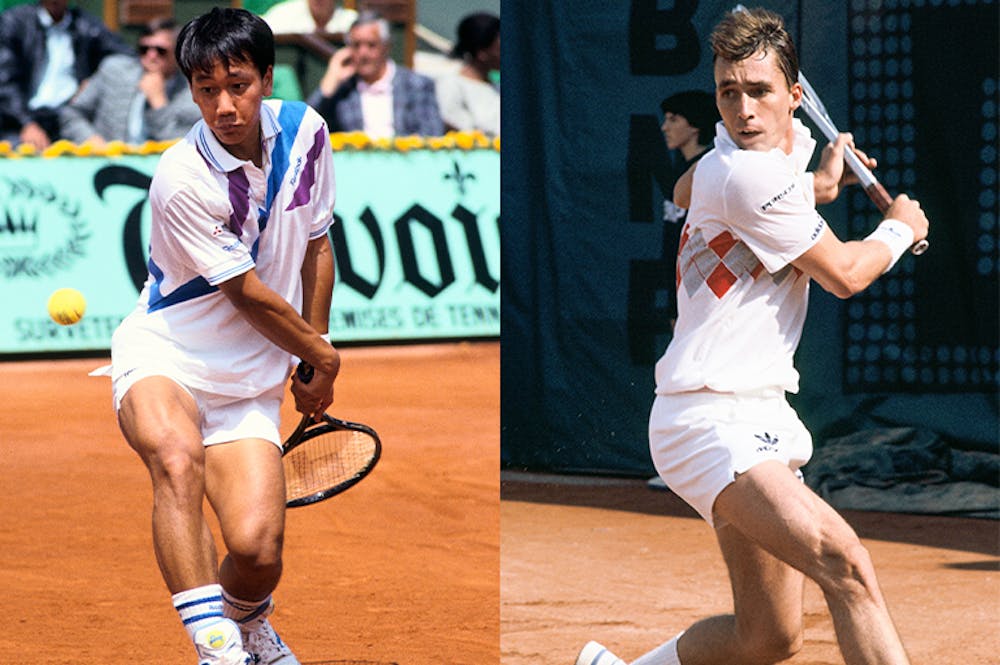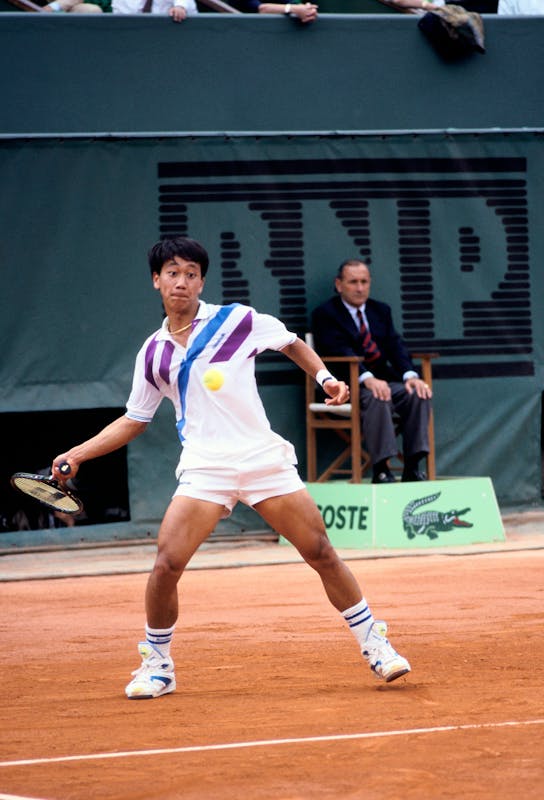Rolandgarros.com invites you to experience the 2020 tournament on the original dates by looking back at some of the most memorable matches from the past, round by round. Today, Sunday 31 May, we look back to 1989 and one of the biggest shocks in Grand Slam history, when a 17-year-old Michael Chang upset three-time champion Ivan Lendl in the fourth round on his way to winning the title and becoming the youngest man to win a Grand Slam title, a record which still stands today.
One day, one epic match: Chang - Lendl (4th round 1989)
Relive the incredible match between Michael Chang and Ivan Lendl at the 4th round of Roland-Garros 1989.

The context
Lendl arrived in Paris as the world No 1 and chasing his fourth Roland-Garros crown in five years. Victory at the Australian Open a few months beforehand had restored him to top spot. He’d lost just twice in 1989 before Roland-Garros, won both his clay-court tournaments, at Forest Hills and Hamburg, before ripping through his first three rounds without losing a set.
Chang was playing at Roland-Garros for only the second time, having reached round three on his debut the year before but then won just four games against John McEnroe. The 17-year-old had broken into the top 20 just before the 1989 event but few gave him a chance of upsetting the world No 1.

The match
For more than two hours, there was no sign of any of the drama that was to come as Lendl, all power and snarl, attacked the Chang second serve at will and surged through the first two sets. But Chang had beaten Lendl in an exhibition event a month or so before Roland-Garros and even as the winners sailed past him, he didn’t panic. The 17-year-old began to pepper the Lendl backhand and he snatched a vital break for 4-3 before closing out the third set. Lendl looked a little rattled and even more so when Chang began to come forward, volleying well and forcing Lendl into mistakes. Another break gave Chang a 4-2 lead in the fourth set and he held the advantage to level the match at two sets apiece.
The fifth set was a classic. First, Chang broke to lead 2-0 but then, the teenager began to cramp, the sheer effort of his comeback beginning to spread through his burning legs. At times he could barely move and he received a warning for “delay of game” as he went to the back of the court for water instead of receiving the Lendl serve. Lendl held for 1-2 and Chang began resorting to moon balls to give himself time, a tactic that drew cackles from the Roland-Garros crowd. Munching bananas and standing up at the changes of ends for fear that if he sat down, he might not be able to get back up, Chang could barely push up on serve and was promptly broken for 2-2.
At that stage it seemed like Lendl would run away with the match but the moon balls were frustrating him, as was Chang’s tactic of standing close to the service line to return serve. In between bouts of cramp, Chang was still playing some great tennis and somehow he broke to lead 3-2. Lendl broke straight back for 3-3 but dropped his serve again in the next game to trail 4-3. It was then that the American produced one of the most iconic moments in Roland-Garros history. Serving at 4-3, 15-30, he pulled out an underarm serve. A surprised Lendl was quickly on to it but his forehand return lacked depth and Chang found time to rip a forehand pass up the line, which clipped off the top of the net and off Lendl’s racquet.
The crowd went wild and suddenly Chang had a new lease of life. As Chang said many years later: “I think from there it just became a huge mental battle for Ivan.” Chang held for 5-3 and then in the next game, he hit three backhand winners to earn two match points. After Lendl missed his first serve, Chang wondered forward, standing just a couple of feet from the service line. The world No 1’s second serve duly clipped the net-tape and landed long, the double-fault giving Chang a stunning, most unlikely victory, 4-6, 4-6, 6-3, 6-3, 6-3.
What they said
“I was surprised that I was able to hang on so long,'' the New York Times reported as Chang at the time. “I just tried to hang on for as long as I could, and knew that if the Lord wanted me to win, I'd win.'' And on his underarm serve: "I knew I had to try something,'' Chang said. ''When I'd go up for a serve, I'd cramp"
Give him credit,” Lendl said of Chang. “It’s very difficult, if not impossible, to play with cramps.”
Match stats
Lendl, usually the perfect mix of power and precision, made 45 unforced errors as he slipped to defeat.
What happened next ?
An inspired Chang recovered physically in time to beat the American, Ronald Agenor in the quarter-finals and then the Russian, Andrei Chesnokov, to reach the final. In the final itself, Chang trailed Stefan Edberg by two sets to one but again produced an incredible recovery to win a five-set thriller and claim his first and what turned out to be only Grand Slam title.
Lendl won the Australian Open the following year for his eighth Grand Slam title but his best years were behind him and he would make just one more slam final, in Australia in 1991. The last of his 94 career titles came in Tokyo in 1993 and he retired the following year.
 ROLAND-GARROS
18 May - 7 June 2026
ROLAND-GARROS
18 May - 7 June 2026

